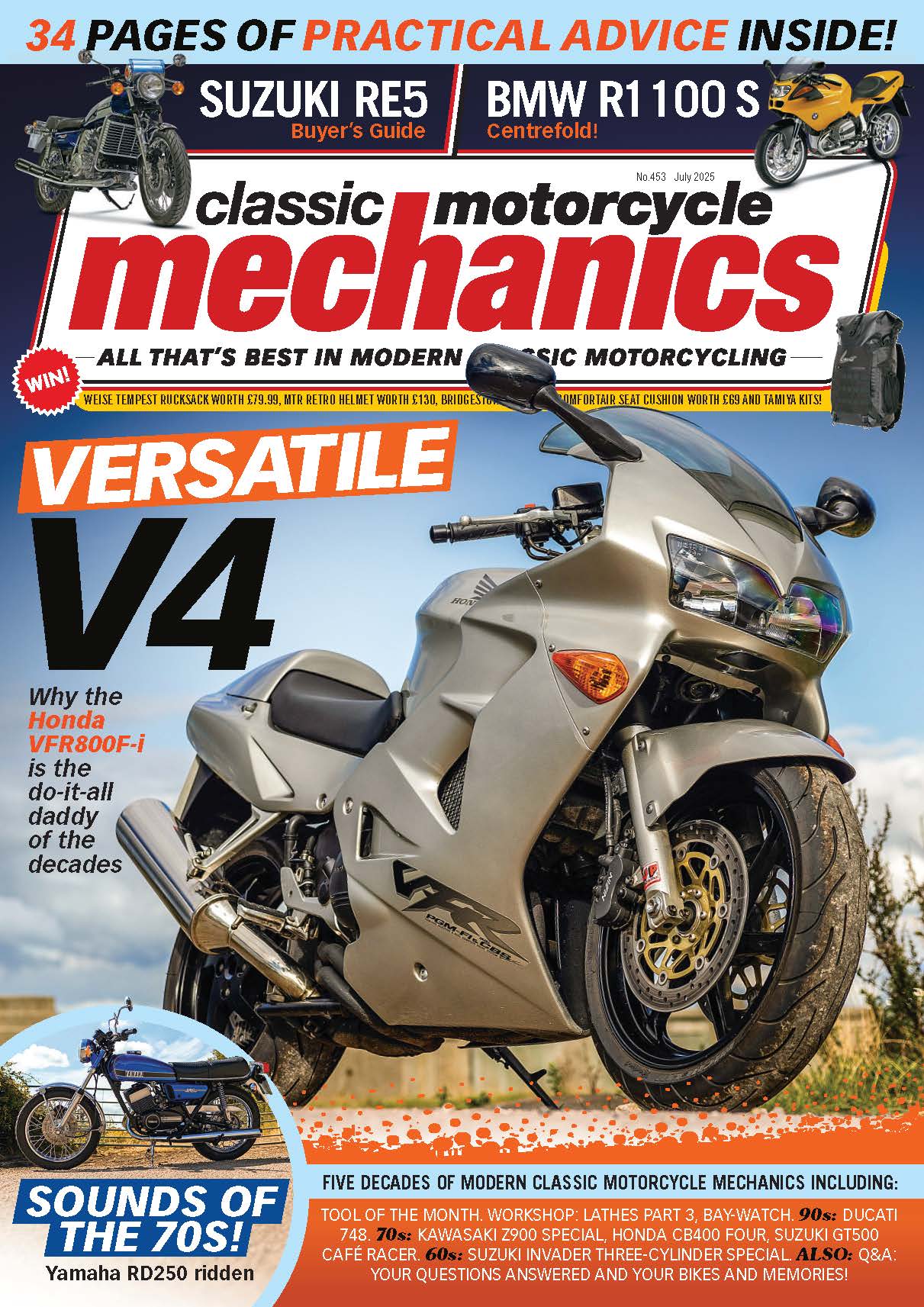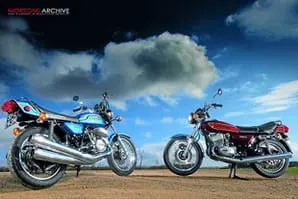
Many things have been written about Kawasaki H2s over the years. The majority of articles tell stories of vicious power deliveries, unintentional wheelies and handling that can leave even the most stoic of riders with something to mutter about. And to a certain degree, they’re all true. But what’s more relevant to any potential purchaser is that the price of buying into this piece of Kawasaki history has risen dramatically in recent years.
When the Kawasaki H2 was first launched in 1972 it cost £754. In the mid-80s you could buy a decent machine for £1500. In the early 90s a tatty unrestored bike would set you back whatever the owner would take for it, which often wasn’t much at all. It’s the nature of the market, and it doesn’t take long for a once state of the art Superbike to become an old and out-dated dinosaur. But then there is the rise of the fallen. If a bike had enough of a reputation in its day then there will always be riders who will at some point decide they wanted that bike they couldn’t afford at the time. In the case of 70s two-strokes, that bike is the Kawasaki H2.
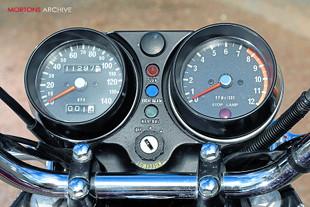 The last decade has seen prices for Kawasaki’s big capacity two-stroke triple rise dramatically. A bike in good usable condition, that only a handful of years ago would have cost less than £1500, will now cost around £5000. If the bike is in good original condition then that’s more likely to be pushing around £7000. And a bike that has been the subject of a professional restoration is going to make a dent in your bank account that’s no smaller than £10,000. Even a cursory glance at some online auction sites will show that an engine in need of a rebuild will set you back over £1000.
The last decade has seen prices for Kawasaki’s big capacity two-stroke triple rise dramatically. A bike in good usable condition, that only a handful of years ago would have cost less than £1500, will now cost around £5000. If the bike is in good original condition then that’s more likely to be pushing around £7000. And a bike that has been the subject of a professional restoration is going to make a dent in your bank account that’s no smaller than £10,000. Even a cursory glance at some online auction sites will show that an engine in need of a rebuild will set you back over £1000.
The question this raises for a classic enthusiast such as a Classic Motorcycle Mechanics reader isn’t whether the bikes are worth it or not, but which one should you buy. I’ll tackle the value thing first though. Take a 2010 Yamaha YZF-R1 as an example. That’s roughly £13,000 to you sir. But if you have no interest in modern motorcycles, and that’s reasonably likely if you’re reading this magazine, you might well be looking to spend a sizable amount of money on a bike that actually means something to you. And for less than the price of a modern 600cc sportsbike (again, probably not your cup of caffeinated beverage), let alone the range topping YZF-R1, you can have one of the bikes that made the 70s such an exciting time for motorcycling development where anything went, and anything that went well was a two-stroke.
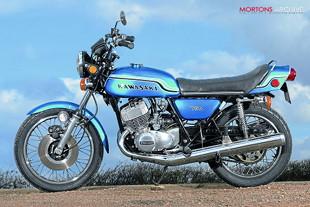 1972 Kawasaki H2
1972 Kawasaki H2
The 1972 H2 (with no suffix) was the first of the models (and the 1973 H2A is to all intents and purposes the same bike). That in itself makes it the most desirable of the 750 triples for some potential owners. And sitting there in its original blue paint scheme it’d be hard to argue otherwise. After all, it was this bike that kick-started the H2’s reputation. H2 aficionado Rick Brett explains a little of where that reputation came from: “People were scared of it and it’s not difficult to see why. They were jumping off something like a Norton or Triumph and onto something completely outrageous. I knew of a bloke who traded his Honda CB750 against an H2 but came back less than an hour later asking for his old bike back. Nothing in those days had as fierce a power delivery. Wheelies in the first two gears just weren’t optional!”
Kawasaki importer at the time, Agrati Sales (there was no real official Kawasaki presence in the UK until 1975), sold 112 of the blue bikes and they didn’t import the gold paint scheme bikes to the UK at all that first year. Rick, who confesses to having what are probably the most complete records for the machines, thinks there are probably 70 of those original UK imports still around. Not a bad survival rate for a 38-year-old bike.
Rick lent us a K-reg machine to see what the fuss is all about. Flip the right peg up, press down the thumb-operated choke on the right hand bar, give the engine two good hard kicks and the engine fires enthusiastically into life. The engine picks up revs aggressively when the throttle is blipped and rattles loudly with all the internal noise amplified through the cooling fins. Where Yamaha fitted rubber dampers to the head and barrel fins on their air-cooled two-strokes to reduce ringing, Kawasaki only saw fit to cast some dampers between the fins on the cylinder head, leaving the barrel fins to amplify any internal engine noise to the world. This is no sanitized and homogenised modern engine that has been compromised to pass ever tightening emissions regulations. This is just about as raw as a motorcycle gets.
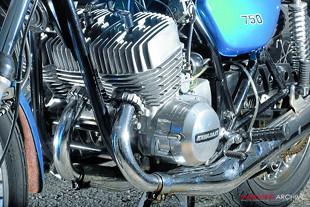 If you’ve been riding a reasonably modern bike (i.e. something less than 25 years old) then the clutch action is going to feel pretty heavy and the 'neutral at the bottom' gearbox takes some getting used to again after years of riding bikes with one gear down, the rest up configurations. First gear needs a bit of clutch slip to get moving but once rolling the big capacity triple is a rare treat. At all revs there is a large reserve of flexible power; just open the throttle further and the engine pulls harder. That’s the beauty of big capacity engines. But it’s when the needle on the rev-counter passes the 5000rpm mark that the blue H2 lives up to its reputation. The way the power comes in is immediate and aggressive, throwing the bike forwards and, if you’re in first gear, the front wheel upwards in a cacophony of noise from the three exhausts. Talking of the exhausts, the sound of the big triple on song and rushing towards 8000rpm is something that’s sorely missing from modern motorcycling. It makes the hairs on the back of my neck stand on end.
If you’ve been riding a reasonably modern bike (i.e. something less than 25 years old) then the clutch action is going to feel pretty heavy and the 'neutral at the bottom' gearbox takes some getting used to again after years of riding bikes with one gear down, the rest up configurations. First gear needs a bit of clutch slip to get moving but once rolling the big capacity triple is a rare treat. At all revs there is a large reserve of flexible power; just open the throttle further and the engine pulls harder. That’s the beauty of big capacity engines. But it’s when the needle on the rev-counter passes the 5000rpm mark that the blue H2 lives up to its reputation. The way the power comes in is immediate and aggressive, throwing the bike forwards and, if you’re in first gear, the front wheel upwards in a cacophony of noise from the three exhausts. Talking of the exhausts, the sound of the big triple on song and rushing towards 8000rpm is something that’s sorely missing from modern motorcycling. It makes the hairs on the back of my neck stand on end.
On the road this flexibility from the engine makes for two ways of riding the bike. You can choose to either take it easy and let the motor pull you at low revs (where 40mpg is possible on a run) or you can keep it above 5000rpm for an exciting and adrenaline filled ride (where it isn’t).
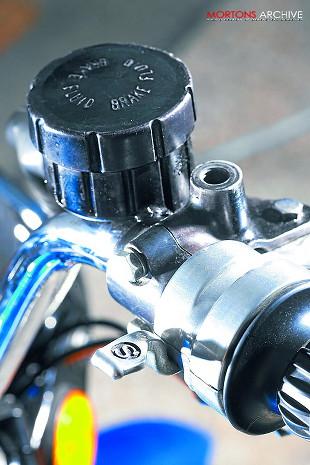 Not quite in keeping with the way the engine goes is the way the brakes stop the bike, or should I say don’t stop the bike. The standard single front disc does little to retard the bike’s motion and judicious use of the rear drum is needed to stop even remotely quickly. Few original buyers fitted the optional second disc because it was ridiculously expensive, something like half the purchase price of the bike but many current owners are doing just that now but it’s expensive. Rick explains: “A genuine brake kit can cost £1200. There are some guys out there making the pieces to do it but that’ll still cost somewhere in the region of £800.” Is the extra disc worth it? “It all depends on how you ride. If you ride one of these quickly then you certainly do need it!” says Rick.
Not quite in keeping with the way the engine goes is the way the brakes stop the bike, or should I say don’t stop the bike. The standard single front disc does little to retard the bike’s motion and judicious use of the rear drum is needed to stop even remotely quickly. Few original buyers fitted the optional second disc because it was ridiculously expensive, something like half the purchase price of the bike but many current owners are doing just that now but it’s expensive. Rick explains: “A genuine brake kit can cost £1200. There are some guys out there making the pieces to do it but that’ll still cost somewhere in the region of £800.” Is the extra disc worth it? “It all depends on how you ride. If you ride one of these quickly then you certainly do need it!” says Rick.
Then there’s the handling. The bike can best be described as enthusiastically nervous. It turns quickly into corners on its skinny tyres and can really be hustled through twisty corners. Although this was a big bike in its day, the H2 feel positively tiny after a diet of four-cylinder Japanese machines. Where it’s not quite so happy is on fast sweeping roads. Try to take them at high speed and the bike likes to weave to the point where the rider isn’t so happy; they’re best avoided unless you like living on the edge. It’s on this type of road that the bike’s reputation for not handling well was born.
1975 Kawasaki H2C
This bike was the last of the H2's short four year line. And in the purple it’s possibly the most sought after of all the bikes (the 1975 purple bike commands £1500 more than the same year’s red bike). Rick recalls a story where he had no enquiries on a particular bike but once he’d modified his advert to say the bike could be repainted purple if so desired, he was inundated with potential buyers. Yet back in the day the purple bike didn’t sell so well.
The H2B (1974) and H2C (1975) are essentially the same bike, both differing significantly from the earlier H2 and H2A. The later bikes have a two-inch longer wheelbase (longer swingarm), different porting, a revised lubrication system (feeding into the carbs rather than cylinders), new switchgear, clocks, fork internals, downpipes, rear wheel, the list goes on. According to Rick the later models are 90% different to the original machine (but interestingly the gearbox swaps between the two with no modification).
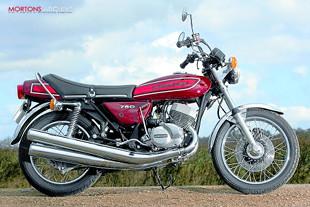 Just a cursory glance at the bodywork confirms his comments. The tank, sidepanels and tail unit/light are completely different. But looks aside, it’s riding the bikes back to back that shows up the real differences between the models. Firstly, the clutch is appreciably lighter. The first bike’s lifter employed four splines, which then progressed to a six spline model and eventually a ball-bearing arrangement that’s roughly one third lighter in operation than the first. Clutch weight aside, the 1975 machine is smoother and the power delivery a little less ferocious. The spread of power seems wider and there is less vibration from the rigidly mounted engine. But don’t let the apparent refinement lull you into a false sense of security; this bike is still a 750 air-cooled stroker that churns out the same power and thrills that gave the H2 its reputation. As one reviewer at the time put the difference between the models – it’s better, but only like putting deodorant on a T-Rex. It’s still a T-Rex.
Just a cursory glance at the bodywork confirms his comments. The tank, sidepanels and tail unit/light are completely different. But looks aside, it’s riding the bikes back to back that shows up the real differences between the models. Firstly, the clutch is appreciably lighter. The first bike’s lifter employed four splines, which then progressed to a six spline model and eventually a ball-bearing arrangement that’s roughly one third lighter in operation than the first. Clutch weight aside, the 1975 machine is smoother and the power delivery a little less ferocious. The spread of power seems wider and there is less vibration from the rigidly mounted engine. But don’t let the apparent refinement lull you into a false sense of security; this bike is still a 750 air-cooled stroker that churns out the same power and thrills that gave the H2 its reputation. As one reviewer at the time put the difference between the models – it’s better, but only like putting deodorant on a T-Rex. It’s still a T-Rex.
The longer wheelbase makes the bike far nicer to ride through fast sweepers, which are the original bike’s Achilles heel. It’s partly this slightly softer, easier to get on with nature, and remember we’re talking shades here, that make the later models so desirable to those that couldn’t afford them the first time around.
'And both models feature Kawasaki’s electronic ignition that Rick is keen to point out makes life so much easier for owners than the three sets of points fitted to Suzuki’s GT750 triple'
There are some nice touches to this bike too. There’s the chain oiler plunger located near the left-hand side panel that dribbles a shot of oil onto the chain and the plug holder under the seat to hold a new set of plugs that you might need after extended periods of town riding without giving it a good thrashing to clear it out. And both models feature Kawasaki’s electronic ignition that Rick is keen to point out makes life so much easier for owners than the three sets of points fitted to Suzuki’s GT750 triple.
If you go to look at any of the H2s as a potential purchase don’t let the rattles and shakes from the engine put you off one. They all do that Sir. Seriously, the H2 models have a very noisy engine. According to Rick an engine with a freshly rebuilt top-end will sound appreciably quieter for about 1000 miles and then it’ll settle back down to churning out the customary H2 rattles and vibration.
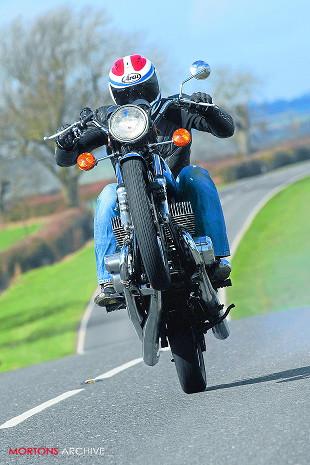 Know what you’re buying
Know what you’re buying
Rick spends half an hour in front of his computer totting up the bikes that were officially imported into the UK in the 70s while he explains that he’s never tallied it up accurately before. The numbers are surprisingly small. I jot the numbers down on my pad as he counts; 1972 – 112, 1973 – 30, 1974 – 105, 1975 – 150. That comes to just shy of 400 H2s imported. The rest of the bikes have been imported from elsewhere, mainly the USA.
The bikes are very similar but there are differences. British bikes have a seat strap and often came with lower bars (European riders were seen as more performance oriented by the factory whereas they saw the American rider as coming from high barred Harley-Davidsons) and generally with no side reflectors. The American models have 'sealed beam' on the headlight and if the bulb goes you have to change the whole headlight assembly. Rick tells me the cheapest option is to get the headlight out of a Mini… There’s also no pilot light and no paint in the 'PO' switch position on the right-hand switchgear.
Another giveaway is the front brake master cylinder – clear plastic on a UK machine and aluminium, or aluminum, on the US counterpart. But remember that after all these years, a typical machine will most likely have a mixture of bits fitted to it. It doesn’t make much of a difference to the price though, and US-sourced bikes are often in better condition because they don’t use road salt during the winter and the bikes have often spent their mechanical lives hundreds of, if not one thousand, miles from any corrosive salt-laden sea air.
If you’ve got the money, and an inkling that you might fancy an H2, now or in the future, then now is the time to buy; prices aren’t going to get any lower that’s for sure. Personally, I’d love one in my garage and I should have bought the one that I went to see 15 years ago (but didn’t because I disliked the seller). There’s an H2-shaped hole in the line-up whenever I start compiling my dream garage, and if you’re a 70s two-stroke man (or lady) at heart then a Kawasaki H2 is something you must ride at least once. Preferably often. And unlike a modern bike you won’t lose any money on your investment either. What’s stopping you? ![]()


